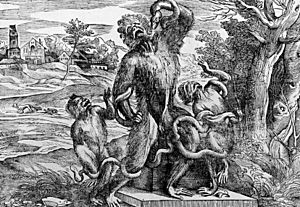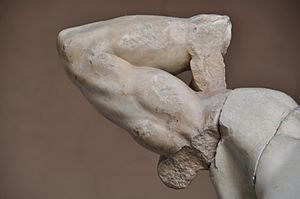Laocoön and His Sons facts for kids
Quick facts for kids Laocoön and His Sons |
|
|---|---|
| Medium | Marble |
| Dimensions | 208 cm × 163 cm × 112 cm (6 ft 10 in × 5 ft 4 in × 3 ft 8 in) |
| Location | Vatican Museums, Vatican City |
3D model (click to interact) |
|
The statue of Laocoön and His Sons is a very famous ancient sculpture. It is also known as the Laocoön Group. This amazing artwork was found in Rome in 1506. Since then, it has been on display at the Vatican Museums, where you can still see it today.
Many people believe this is the same statue that Pliny the Elder, a famous Roman writer, wrote about. He said it was made by Greek sculptors. The figures in the statue are almost life-sized. The whole group is just over 2 meters (about 6.5 feet) tall. It shows a Trojan priest named Laocoön and his two sons. They are being attacked by giant sea snakes.
The Laocoön Group is known for showing intense human suffering. The faces of Laocoön and his sons show great pain. Their bodies are twisted and straining. This makes the statue very powerful and dramatic.
Contents
Who Made the Laocoön Statue?
Pliny the Elder said that three Greek sculptors made this artwork. Their names were Agesander, Athenodoros, and Polydorus. They were from the island of Rhodes. The statue was found in the palace of Emperor Titus long ago.
The style of the statue is called "Hellenistic baroque." This means it is very dramatic and emotional, like other Greek art from that time. We are not sure if it is an original Greek artwork or a copy made later by Romans. Many experts now think it was made during the early Roman Empire, between 27 BC and 68 AD. It was likely made for a rich Roman family.
What Story Does the Statue Tell?
The story of Laocoön comes from the Greek tales of the Trojan Wars. It is not in Homer's famous poems. But other Greek writers told different versions of the story. The most well-known version is from Virgil's poem, the Aeneid. This poem was written between 29 and 19 BC.
In Virgil's story, Laocoön was a priest of Poseidon, the god of the sea. He tried to warn the Trojans about the Trojan Horse. He even threw a spear at it. Because of this, sea serpents were sent to kill him and his two sons. The Trojans saw this as a sign that the horse was sacred. They thought Laocoön was being punished for harming it.
In other versions of the story, Laocoön was a priest of Apollo. He was supposed to be single but got married. In some tales, only his sons were killed, and he was left to suffer. The snakes in the statue look like they are biting and squeezing the figures. They are probably meant to be poisonous, just like in Virgil's poem.
How Was the Statue Found?
The Laocoön Group was discovered in February 1506. It was found in a vineyard owned by Felice De Fredis in Rome. When Pope Julius II heard about it, he sent his artists to see it. Michelangelo was one of the first people to see the statue after it was dug up.
Francesco da Sangallo, who was a young boy at the time, later wrote about the discovery. He said his father, Giuliano da Sangallo, immediately recognized it as the "Laocoön" mentioned by Pliny. The Pope bought the statue and put it on display in the Belvedere Garden at the Vatican. This is considered the start of the Vatican Museums.
In 1798, the statue was taken to France by Napoleon Bonaparte after he conquered Italy. It was displayed in the Louvre museum in Paris. After Napoleon's defeat in 1815, many artworks were returned. The Laocoön statue came back to Rome in 1816.
Restoring the Statue
When the statue was found, some parts were missing. Laocoön's right arm was gone, along with parts of his sons' arms and sections of the snakes. Artists and experts debated how to fix it. Michelangelo thought Laocoön's missing arm should be bent back over his shoulder. Others thought it should be stretched out.
For a long time, the statue had a straight, outstretched arm added by a sculptor named Giovanni Antonio Montorsoli in 1532. But in 1906, an archaeologist named Ludwig Pollak found a marble arm fragment near where the statue was first discovered. This arm was bent, just as Michelangelo had suggested.
In 1957, the Vatican Museum decided this bent arm belonged to the original statue. It fit perfectly! In the 1980s, the statue was taken apart and put back together with this original arm. The arms that had been added to the sons were also removed. This made the statue look much closer to how it was originally made.
How the Statue Influenced Art

The discovery of the Laocoön statue had a huge impact on artists in Italy. It continued to influence art for hundreds of years. Michelangelo was very impressed by its large size and the way it showed the human body. You can see the influence of the Laocoön in many of Michelangelo's later sculptures. For example, his figures on the Sistine Chapel ceiling show similar strong, twisting bodies.
Many copies of the statue were made. The Florentine sculptor Baccio Bandinelli made a famous copy for Pope Leo X. There are also many smaller bronze copies. A bronze copy made for King François I of France is now in the Musée du Louvre. You can find copies of the statue all over the world.
Artists like Titian and Rubens also studied the Laocoön. Titian even made a funny drawing that showed the Laocoön group as apes. This might have been a joke about other artists' copies or a comment on how humans and apes are similar. The statue's dramatic style and powerful emotions inspired many artists to create their own masterpieces.
The Laocoön as a Great Work of Art
Pliny the Elder called the Laocoön "a work to be preferred to all that the arts of painting and sculpture have produced." This led to many discussions about whether it truly is the greatest artwork ever.
Thinkers like Johann Joachim Winckelmann and Gotthold Ephraim Lessing wrote about the statue. Lessing compared the sculpture to Virgil's poem. He argued that artists had to show suffering in a beautiful way, without making it too painful to look at.
Johann Goethe also admired the statue. He said that a true work of art, like nature, never stops revealing new things to your mind.
Not everyone loved the statue, though. John Ruskin thought it showed "disgusting convulsions." He preferred the "awfulness and quietness" of Michelangelo's work. He also criticized the snakes in the statue, saying they didn't look realistic.
The Laocoön has continued to inspire modern thinkers and artists. It remains a powerful symbol of human struggle and artistic expression.
Where Was the Statue Found Exactly?
The exact spot where the statue was found in 1506 was known as "the vineyard of Felice De Fredis." This vineyard was on the Oppian Hill in Rome. For a long time, the precise location was lost. People only knew it was "near Santa Maria Maggiore" or "near the site of the Domus Aurea" (Emperor Nero's palace).
Recent research in 2010 found old documents that pinpoint the location much more accurately. It was found slightly east of the Sette Sale, which was a large ancient water storage system near the Colosseum.
It is thought that the statue was discovered when Felice De Fredis was digging foundations for a new house or a well. The statue was found about four meters (13 feet) underground. This area was once part of the Gardens of Maecenas, a famous garden owned by a friend of Emperor Augustus. It's possible the statue was placed there long ago, perhaps even for Emperor Titus, who Pliny said owned it.
Images for kids





